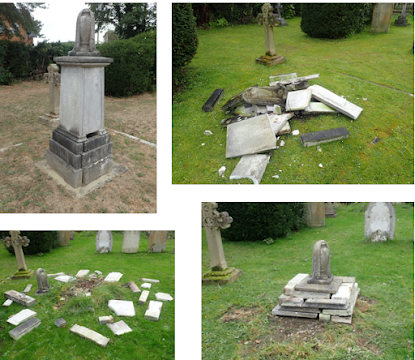Hitchin Cemetery October - December 2024
As usual in October, the Ivy along the old cemetery wall was full of flowers which attracted lots of Ivy Bees (below left), plus Honey and Bumble Bees and Hoverflies (below right) and the Ivy fruit will provide food for birds throughout the winter.
When the weather got chillier the trunks of trees were a good place to find insects basking on sunny days, such as this Southern Oak Bush Cricket with its extremely long antennae (actually spotted on a Beech tree), and Batman Hoverfly (can you make out the dark bat's wing design?).
The cemetery has numerous Silver Birch trees, which look fantastic all year round and support numerous types of wildlife, some of which I'll share with you later on, but one of the old trees blew over in storm Darragh. It was cleared away very efficiently within 24hours, as shown below. Silver Birches are not long-lived trees with typical lifespan of 100 - 150 years: if this one was planted when the cemetery was laid out in 1857 that makes it about 167 years old and therefore it had a very good innings! Silver Birches are food plant for over 100 British moth species - such a good all-round tree!

The most numerous creatures to be seen on Birches are not terribly glamorous but most leaves are host to several aphids, often of more than one species. These aphids of course are food for birds found in the cemetery like Blue Tits and Goldcrests and they also food for other insects and spiders. The photo below left shows aphids I saw under a |Birch leaf at three stages of development and on the right is a hoverfly larva, well-known as the gardener's friend because they consume so many aphids, and this one seems to have cleared the leaf of its favourite food.
An extremely numerous insect are Birch Catkin Bugs which are superbly camouflaged when they sit on the old catkins but more obvious when they're on a leaf. I also spotted a weirdly black-looking Harlequin Ladybird on a Birch leaf too, and that too had probably had a meal of aphids.
In November the of the areas of the cemetery where long grass is allowed to develop had their "conservation cut". These important areas for wildlife benefit from having the old grass removed, not only do they look tidier, but the removal of the grass helps reduce the soil fertility and allows more delicate plants such as Scabious to survive their competitive neighbours such as some of the grasses. The photo shows the distinction between a green "amenity cut" and browner "conservation cut" areas. The exact areas which are amenity and conservation are defined in the cemetery's 5-year Green-space Action Plan (a new version is due for publication by NHerts council imminently).
In November I came across a Woodlouse Spider (who knew such a thing existed?) which decided that under my watch-strap was a suitable place to search for Woodlice. The next bit you may wish to skip over if you less keen than I am about more gruesome bits of wildlife... I spotted a fly killed by a fungal attack. This fungus is called Entomophthora muscae and it not just kills the fly but affects the fly's brain such that when it is critically ill it crawls to a high point, straightens its hind legs, opens its wings and then dies! This behaviour ensures that the fungal spores are dispersed as widely as possible. I used to imagine this sort of weird behaviour was very rare and one might come across it on a David Attenborough programme, but it's happening here in Hitchin Cemetery.
Throughout autumn, as expected, there were numerous fungi which popped up here and there including an attractive bracket fungus, the weirdly shaped White Saddle (new to the cemetery, just behind the St John's Rd gate) and some Inkcaps.
A final non-wildlife note about a monument which unfortunately collapsed back in mid-summer; its inscription cannot be found (at least by me) but luckily I had a photo from before the collapse which shows what it used to look like. In general the Friends of Hitchin Cemetery do not get involved with moving masonry but in this case, after leaving the debris for some months to see if anyone might have organised a repair, in the end we tidied the pieces up in to a pile which looks a little better than before, and keeps the pieces together.
The next few months will see the Hitchin Cemetery friends group doing their best to keep the bushes trimmed, graves weeded, bird-boxes cleaned, litter picked, fallen branches tidied, etc, etc
















Comments
Post a Comment